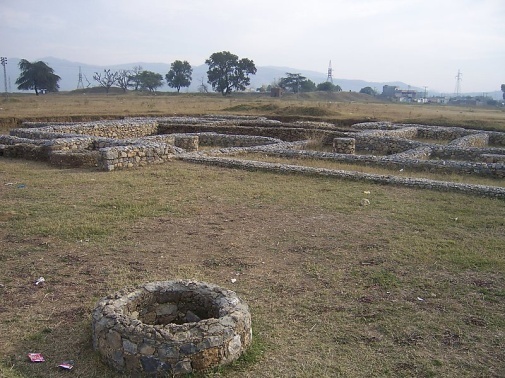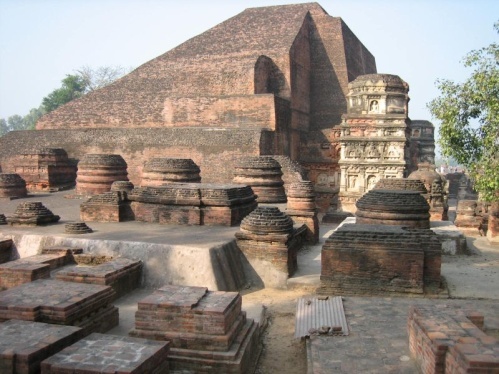The convention dictates that if you plan on writing about ancient India, it should begin with a Sanskrit shloka. Well, what can I say? The cliché never gets old. So here is one,
विद्या नाम नरस्य कीर्तिरतुला भाग्यक्षये चाश्रयो
धेनुः कामदुधा रतिश्च विरहे नेत्रं तृतीयं च सा ।
सत्कारायतनं कुलस्य महिमा रत्नैर्विना भूषणम्
तस्मादन्यमुपेक्ष्य सर्वविषयं विद्याधिकारं कुरु ॥
Most of the readers would be Indian, here are three questions that you must ask yourself before you scroll down,
• Did I read each and every word of the shloka?
• Did I intentionally skip the shloka to find its translation in familiar language?
• Even after reading the shloka, did I get it?
If you end up with more than one ‘no’, here is a fun insight. If you ever wondered about the downfall of ancient system of Gurukul, now you know who has to share the blame. That is enough loose talk for one day. Here is what that shloka means,
Knowledge is the unrivalled fame of man, it gives shelter when destiny is destroyed. Knowledge is Kamdhenu, it is coition in separation.
Knowledge is the third vision, the temple of love, the glory of the clan.
It is the jewel without gems. Thus rejecting all other matters one must become learned.
In the ancient times India had the gurukul system of education in which anyone who wished to study went to teachers house and requested to be taught, the knowledge which teacher used to deliver was mainly oral and the students were able to grasp it by memorising the vocals.The knowledge imparted to the students was not only limited to subject or curriculum. The students were even taught how to manage their homes and earn respect in society. The guru taught everything the child wanted to learn, from Sanskrit to the holy scriptures and from Mathematics to Metaphysics.
If for once, the Hindu philosophy of cyclical nature of time(kala) is ignored and the western notion of time is considered, the system of education in ancient India revolves around the Guru-Shishya parampara. Gurukul, the institution where this tradition was realised, had the Vedas as their primary syllabus, reason for which the Gurukuls were also known as Vedapāṭhaśālās.
In Ancient India from the Vedic Age education was regarded as a source of “Illumination”, giving a person a correct approach for leading a successful and honourable life. The ancient Indian educationists have regarded education as an agency of improvement.

Merits of Gurukul System
1. The Gurus had large amount of information and knew how to instruct the most troublesome things.
2. This Parampara used to take as much time as needed and shishiya have more time to learn and become meticulous.
3. This system helps to acquire high level of efficiency.
4. The shishya have high regards for Guru.
5. The teaching was more of practical and shishya enjoying learning.
6. Environment in gurukul teaching ensured that shishiya should accomplish in his field of interest.
7. The Gurukul education also focused on physical and mental fitness which consisted of regular practice of yoga and meditation. The shishya also learned how to use different weapons like swords, bow and arrow and also received self defense training.
“If there is one thing the Vedas are not, it is books” – Frits Staal
The Vedas are eternal (anādi) and from non-human authorship (apauruṣeya). The wisdom of the Vedas passed from the Guru to his Shishya from time immemorial.
The manuscripts of one of the oldest Vedas i.e Rigveda is dated to be as old as 1750 BCE. But on a scale of Sanatan Dharm, what appears to be old for the world is new.
The outstanding feature of the oldest Indian education is its orality. The Vedic texts make no reference to writing and there is a reason.
– Mahabharata XIII 24.70 says, “ vedanamlekhakascaiva tevai niraya-gaminah ”that translates to those who write down the Veda go to hell.
– In Tantra-varttika I 3, Kumarila confirms: “That knowledge of the truth is worthless which has been acquired from the Veda, if the Veda has not been rightly comprehended or if it has been learnt from writing.”
– Sayana wrote in his Rigveda commentary that “The text of the Veda is to be learned by the method of learning it from the lips of the teacher and not from a manuscript.”
The need to recite the Vedic mantras with correct accents and intonations, if disaster is to be avoided, reinforced the need for oral instruction and thus the Vedas went unwritten for a long time. Many scholars link it with the lack of script but enough evidence suggest the presence of Kharosti and Brahmi script (lipi) older than the written manuscript of the Vedas. A quick example will make it clear,
Islam emphasises over the word ‘Makhtub’ for determinism that means ‘It is written’
Biblical tradition has statement like ‘As it is written in the book of prophecies of Isaiah’
Whereas Indian texts mention phrases like ‘As it is heard’ (Svetasvatara-Upanishad)
It is often forgotten in our script- centred worldview that manuscripts and books are not only texts; they are artifacts and, as such, they can play different roles in a given context. Manuscripts can have at least two roles: ‘cultic’ and ‘discursive’. The main difference between the discursive and cultic roles is that, in the discursive, the words of the text are actually read, whereas in the cultic, the manuscript as a whole is treated iconically, generally as a physical embodiment of a particular knowledge.
Coming back to the Gurukul system of education, now we know that the ancient system of education revolved around Vedic Corpus such as –
– Four Vedas
– Six Vedangas (phonetics, ritualistic knowledge, grammar, exegetics, metrics and astronomy)
– The Upanishads – The six Darshanas (nyaya, vaiseshika, samkya, yoga, mimamsa and vedanta)
– Puranas (history)
– Tarka Shastra (logic)
Indian learning is so much indebted in its origin to the Vedic tradition that the verbal skills (grammar, debate, logic), ritual techniques (involving geometry, arithmetic), and metaphysics and introspection (yoga) saw spectacular development, whereas the study of foreign cultures and languages was disdained as unworthy. The study of the physical world (physics, chemistry, mechanics) was left—as merely material and without religious merit to the craftsmen belonging to the lower classes (not quite unlike in the European Middle Ages). This neglect of the physical world had—besides the Vedic tradition and the social discrimination against the “blue collar worker”—a psychological reason. There is a deep-seated yearning for an “ultimate reality” beyond the mere “world of facts”.
The most common misconception about the Gurukul system of education is that education was only given at the premise of the preceptor (Guru) and the student had to spend many years outside the comfort of their home to get educated. While this concept isn’t entirely false but there was a strong structure of education, about which much is learned from the ruins that date several centuries back.
The structure of ancient education system
• Brahmapuri – A specially organised town dedicated for the learned Brahmins.
• Mathas – A place attached with temples where pupils used to worship and learn.
• Ashrams – Abode of the hermits who used to educate students from various regions. Entry to these hermitages were limited.
• Goshti – Conferences organised by Kings where debate over Vedas took place. Winners were given villages and cows. Besides debate, views were also exchanged.
• Parishads – Seminars of higher learning students were put up. Advanced concepts were discussed.

Source:http://www.world66.com/asia/southasia/pakistan/taxila

Source: http://www.flickr.com/photos/princeroy/93462777/

University at Nalanda and Taxila witnessed the peak of Indian education. Vedic chants were perused in the dedicated lecture halls but the subcontinent eventually saw its darkest times.
Nalanda was ransacked by Muhammad bin Bakhtiyar Khalji. Khalji was assigned two villages on the border of Bihar which had become a political no-man’s land. Sensing an opportunity, he began a series of plundering raids into Bihar and was recognised and rewarded for his efforts by his superiors. Emboldened, Khalji decided to attack a fort in Bihar and was able to successfully capture it, looting it of a great booty.
Similarly, Taxila was invaded by the Kiderites in 450 CE. Though repelled by the Gupta Emperor Skandagupta, the city would not recover- probably on the account of strong Hunnicpresence in the area, breakdown of trade as well as the three way war between Persia, the kidarite state, and the Huns in western Gandhara. Vallabhi also succumbed to the attack of the Arabs.
Reference/s :
Borayin Larios : Embodying the Vedas( 2017)
EDUCATION IN ANCIENT INDIA BY HARTMUT SGHARFE (2002)
F.Max Miiller, Lectures on the Origin and Growth of Religion, New York
A Sanskrit-English Dictionary, Oxford 1899
SudhirKakar, The Inner World
Wikipedia




18 replies on “Education System in Ancient India”
Very nice
I am looking for a richa from rigved which says education is nothing but character building. I can’t find the slok…Pl help
This is really good work, looking forward to a lot more stuff
Interesting stuff, looking forward to more such content.
“Amazing write-ups”! Keep up the great work.
?????
Great …..keep it up✌️??
Excellent work
Nyc….
Keep it up
Awesome stuff.
Looking forward to more of them.
Excellent job
Nice work…
It’s really interesting to know about the ancient education system…
Good job
New blog related to the Decline of Education System in ancient India is up. Check it out at: https://sanelywritten.com/2020/07/23/decline-of-education-system-in-ancient-india/
very nice work.wanted to know more about PUSHPAK VIMAN,AND INVENTION OF “0”
Are there any ancient manuscripts of Sanskrit alphabet taught in Gurukulas ?
If by the manuscript, you meant the written artefacts, then the oldest know manuscript is Spitzer manuscript which was discovered in 1906. According to carbon dating, it belongs to time-frame of around 80-230 CE (closer to 230). So, strictly speaking, it is not the same Sanskrit as of Vedas, it is more like a modern Sanskrit.
And if by manuscript, you meant the Vedic Sanskrit, then that Sanskrit is different from the Vedic Sanskrit. There were grammar books for Vedic Sanskrit called Pratishakhya.
It is mention-worthy that, varṇamālā and lipimālā was separately taught to the children. Varṇamālā was taught verbally and almost similar throughout the country. But lipis were vernaculars. Interestingly, there is no particular lipi specified to any particular language. Even today there is a celebration of Akṣarārambha for the children where the children starts writing on an auspicious tithi.